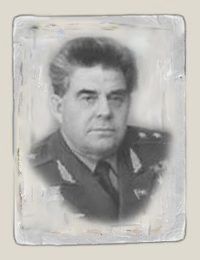Georgy Beregovoy
 15.4.1921 - 30.6.1995 15.4.1921 - 30.6.1995 Georgy Beregovoy was a bomber pilot, test pilot, the Soviet 12th cosmonaut. He was born on April 15, 1921 in Fedorovka village, Poltava region, the Ukraine. Ukrainian. After graduating from Yenakiyevo high school in 1938, he started his career at Yenakiyevo Metallurgical Combine. In 1938, he volunteered for the Red Army and became a cadet of the Voroshilovgrad school of military pilots named after Donets Basin’s proletariat, from which he graduated in 1941. From June 13, 1941 he was a pilot of the 314th Reconnaissance Aviation Regiment of the 28th Air Division of the Central Front. From October 3, 1941 - a pilot of the 15th Reserve Aviation Regiment of the Volga Military District. Since February 1942 – a pilot of the 150th Short Fighting Aviation Regiment of the Volga Military District. This Aviation Regiment was later renamed into the 451th Attack Aviation Regiment. Before being sent to active duty, Georgy Beregovoy flew on the Yak-4 and the R-6. Participated in the Great Patriotic War from August 1942. From August 15, 1942 he was a flight commander of the 451th Attack Aviation Regiment (the 3rd Air Force, the Kalinin Front). On November 18, 1942 Georgy Beregovoy was appointed Commander of the 235th Attack Aviation Regiment (the 264th Assault Aviation Division, the 3rd Air Force, the Kalinin Front). A member of the CPSU (B) / Communist Party since 1943. From March 25 to September 5, 1943 G. Beregovoy was Squadron Deputy Commander of the 671th Attack Aviation Regiment (the 212th Assault Aviation Division, the Kalinin, and then the Voronezh Front). In May 1943, the 671th Attack Aviation Regiment became the 90th Guards Attack Aviation Regiment, and from September 15, 1943 to June 3, 1945 Georgy Beregovoy was Squadron Commander of the 90th Guards Ground Attack Aviation Regiment (the 4th Guards Attack Air Division, the 5th Attack Air Corps, the 5th Air Army, and the 1st Ukrainian Front). During the Great Patriotic War, Guards Captain G.Beregovoy made 185 sorties, flying the Po-2, the P-5, the SB, and the IL-2. During one battle he got a slight bullet in the leg left. By the Decree of the Presidium of the Supreme Soviet on October 26, 1944 for the exemplary performance of military missions at the front of fighting the German invaders, and for his bravery and heroism, Guards Captain Georgy Beregovoy was awarded the title of Hero of the Soviet Union, the Order of Lenin and the Gold Star medal (№ 2271). After the war, in 1945, G.Beregovoy graduated from the Supreme officers’ school. Subsequently, until 1964, he was a test pilot in the Chkalov State Red Banner Scientific Testing Institute of the Air Force. He tested more than sixty types of the aircraft. In 1956 he graduated from the Air Force Academy. On April 14, 1961 he was awarded the title of Honored Test Pilot of the USSR. Since 1964, Colonel G.Beregovoy was in the Soviet Cosmonaut Corps. From 26 to 30 October 1968, he took the Soyuz-3 into outer space: he multiply orbited the Earth and twice maneuvered his craft into rendezvous positions with the unmanned Soyuz-2 satellite; made a series of technical experiments working out systems and equipment of Soyuz spacecraft, as well as observations in order to study the near-Earth space. The Flight Duration: 3 days 22 hours 50 minutes 45 seconds. For the successful implementation of an orbital flight, his courage and heroism, by the Decree of the Presidium of the Supreme Soviet on November 1, 1968 the Soviet cosmonaut, Colonel Georgy Beregovoy was awarded the second Gold Star medal (№ 48) and the Order of Lenin. Since 1969, Major General of Aviation, Georgy Beregovoy was Deputy Chief, and since 1972 - Head of the Centre for Cosmonaut Training named after Gagarin. In 1977, Georgy Beregovoy was awarded the military rank of Lieutenant General of Aviation. Since 1987 he was retired. Georgy Beregovoy had works in the field of astronautics and engineering psychology. PhD in Psychology. He was a co-author of scientific discoveries in the physics of the upper atmosphere. A member of the Supreme Soviet of the USSR in 1970-1982. Laureate of the USSR State Prize in 198. Did a lot of social work: he was a commander of the All-Union Komsomol military-sports game “Orlyonok” (Eaglet); a commander of the All-Union young army movement; a commander of the headquarters of a unified military and youth patriotic movement. He was elected Deputy Chairman of the Central Board of the Soviet-Hungarian friendship, a member of the Presidential Council of the society, “the Soviet Union – France”; chairman of the Central Board of the Soviet-Polish friendship. He was elected Council Chairman of Inter-republic union of veterans and soldiers of the Armed Forces of the USSR reserve. He was a member of the Soviet Committee for European Security. He lived in Chkalovsky village (Chkalovskaya station in the city of Shchelkovo) of the Moscow region, then – in Zvezdny Gorodok (the Star City). He died on June 30, 1995. He was buried in Moscow at Novodevichy cemetery. The Honorary citizen of Kaluga (Russia), Lugansk, Yenakiyevo, Vinnitsa (Ukraine), Pleven, Sliven (Bulgaria). In grammar school № 37 of Yenakievo, at the museum of the national education, a section dedicated to the glorious countryman, is open. There, in Yenakiyevo, a bronze bust of twice Hero of the Soviet Union, Georgy Beregovoy was installed. In the village of Chkalovsky at the house where the hero lived, a memorial plaque was set up. He was awarded two Orders of Lenin, two Orders of the Red Banner, the 3rd Class Orders of Alexander Nevsky and Bogdan Khmelnitsky, two Orders of the Red Star, two 1st Class Orders of the Patriotic War, medals. He was awarded the gold medal of Y. Gagarin (FAI), the Medal of Henry De Lavaulx (FAI), was also awarded the prize of Tsiolkovsky. Hero of Socialist Labor of the People's Republic of Bulgaria (1970). He was awarded a number of foreign orders and medals. |




